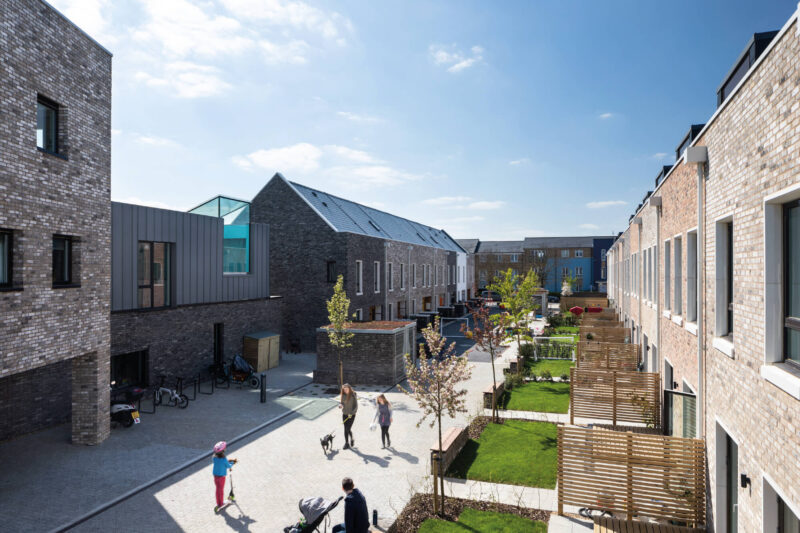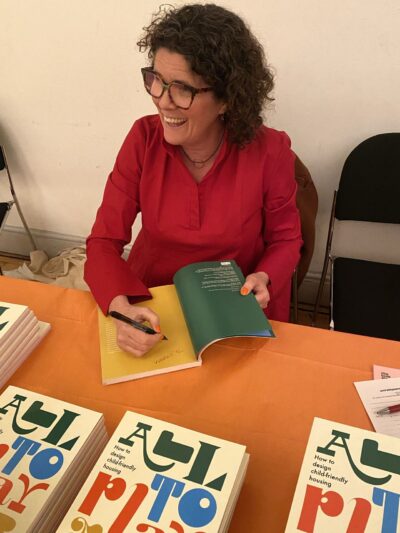18th March 2025
ALL TO PLAY FOR: HOW TO DESIGN CHILD-FRIENDLY HOUSING.
18th March 2025
ALL TO PLAY FOR: HOW TO DESIGN CHILD-FRIENDLY HOUSING.
Share
This month, we celebrated the launch of All to Play For: How to Design Child-Friendly Housing, from RIBA Publishing, written by leading architect and TOWN collaborator Dinah Bornat.
The book addresses a critical question: How can we meet the needs of children and young people in the built environment? With over 20% of the UK population under the age of 18, their needs remain largely overlooked in housing design. Dinah’s work makes a case for integrating child-friendly principles into residential developments, offering practical solutions for creating homes and communities that actively support young people’s wellbeing, play, and independence.

All to Play For, Dinah Bornat.
Marmalade Lane: A model for child-friendly housing.
Marmalade Lane, TOWN’s award-winning cohousing development in Cambridge, is featured as a key case study in All to Play For, offering a look at how community-orientated design can create a child-friendly, supportive, and intergenerational neighbourhood.
One of the strongest themes running through the case study for Marmalade Lane is the freedom and independence it offers children. Unlike conventional housing developments where roads and parking dominate outdoor space, Marmalade Lane prioritises communal areas and play. As resident and mother of four Hannah explains, “There’s always someone around. There’s usually a child knocking at the door asking if one of ours can come out to play, sometimes at both doors.” The Lane—a shared play street with minimal vehicular access—effectively extends children’s homes into a safe outdoor environment where play happens organically.
The communal garden also plays a vital role, offering a mix of informal play and structured features like a sunken trampoline, climbing frames, and a firepit. This flexibility allows children to shape the space as they grow. Hannah describes how “You’ll have a couple of months where they’re all really into football and they’ll totally destroy the lawn and then move on to something else.” The design anticipates this natural ebb and flow, ensuring the space works for different age groups over time.
The case study highlights that the community dynamic benefits not just children but parents too. The design encourages informal socialising and shared responsibility, helping to ease the pressures of parenting. Hannah reflects on this, saying, “It takes the pressure off, as when you’re a nuclear family and it’s just you and your children, it can be quite intense. It’s provided us with a social life which we just didn’t have at all before.”

The car-free lane.
Another significant takeaway is the intergenerational interaction that the layout facilitates. Children form relationships not just with peers but with a wide network of adults. Some residents organise craft sessions, while others help with gardening or general upkeep of shared spaces. This creates a strong sense of belonging and offers children a broader range of role models and influences beyond their immediate family.
Marmalade Lane demonstrates that strong social cohesion can be as effective as physical barriers. The development is not gated, yet Hannah feels safe: “I know everyone who lives here, so I can tell if anyone is a stranger.” Instead of excessive restrictions, small interventions—such as planters to deter cut-through cyclists—help maintain a sense of ownership and safety.
Dinah Bornat’s research and advocacy for child-friendly housing are at the heart of All to Play For. Her work highlights the essential role of thoughtful urban design in creating places that support not only children’s development and independence but also a stronger sense of community. Through practical guidance, compelling evidence, and illustrated case studies like Marmalade Lane, Dinah provides a roadmap for integrating child-focused principles into contemporary housing design.
A crucial takeaway from the book is that child-friendly housing is not just beneficial for children—it creates better places for everyone. When developments prioritise communal spaces, reduce reliance on cars, and foster connections between neighbours, they cultivate healthier, more resilient communities. All to Play For serves as a call to action for architects, developers, and policymakers to rethink how we design the spaces where people live.




